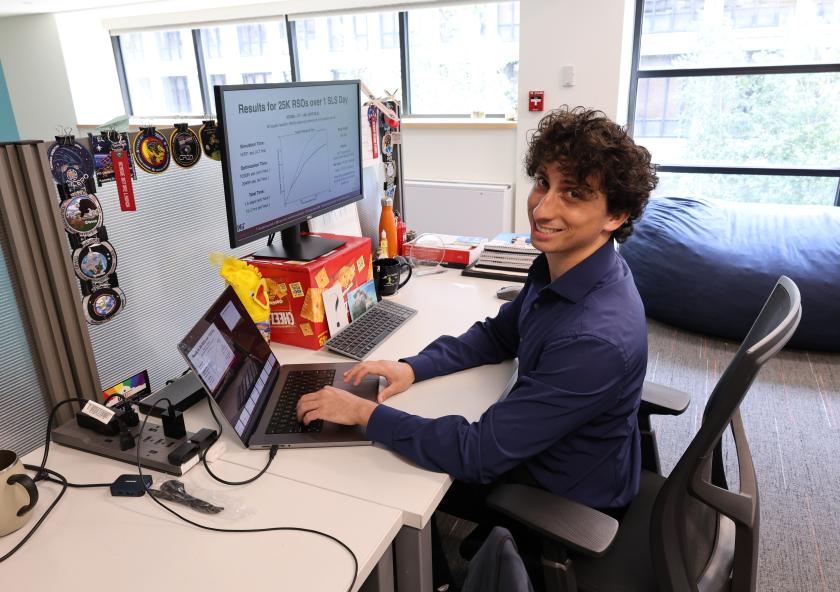
Keeping the cosmos clean

Asked to describe his work for a lay audience, Allan Shtofenmakher responds with an unexpected question: “Have you ever seen the movie 'Wall-E?'” Recalling that the 2008 Disney-Pixar movie’s view of Earth from space was “brown and dusty and just surrounded by tons and tons of space junk,” he cautions, “If we’re not good stewards of our local space environment, we could actually end up in a situation like that — where we can’t get anything into space because it’s so cluttered and dirty.”
Shtofenmakher, a PhD student, works in MIT’s Dynamics, Infrastructure Networks, and Mobility (DINaMo) research group under the guidance of Hamsa Balakrishnan, the William E. Leonhard Professor of aeronautics and astronautics (AeroAstro) and associate dean of MIT’s School of Engineering. “A lot of my work,” he continues, “is trying to keep space sustainable.” When satellites or spent rocket bodies crash into each other, they create space debris moving in different directions at very high speeds. “Then they’ll create even more junk that can crash into each other … and you end up with a completely unsustainable space environment.”
Shtofenmakher’s research interests reside at the intersection of space situational awareness and control of multi-agent systems, with a focus on tracking orbital debris using in-space satellite sensors. He is experimenting with techniques such as mixed-integer programming and multi-agent reinforcement learning to maximize our awareness of — and ability to avoid — rogue objects orbiting the Earth at speeds 10 times faster than a bullet. “My goal is to leverage the cameras on the thousands of active Earth-orbiting satellites to keep the space around Earth clean and sustainable for generations of space explorers to come,” he says.
After earning a bachelor’s degree in aerospace engineering from the University of California at Irvine, and a master’s in aeronautics and astronautics from Stanford University, Shtofenmakher worked as a spacecraft systems engineer on several small satellite programs. “I decided to return to graduate school to solve some of the challenges associated with distributed satellite networks,” he says, “and I chose MIT AeroAstro for its wealth of expertise in both satellite systems and multi-agent systems.”
“A lot of my work had been broader and more general in aerospace engineering, and I wanted to become good at something. That something was controls and optimization."
A life-changing conversation
When Shtofenmakher was originally applying to PhD programs, he says, “I wanted to work with actual spacecraft and hardware … on what are called CubeSats, which are these really small, student-built satellites that can be sent into space for cheap to do something cool and novel.” He received a call from Balakrishnan, whose research had focused primarily on air traffic control and optimization but was now shifting into space research. Reviewing his graduate school application, she thought Shtofenmakher’s expertise would be helpful in her lab.
“What Hamsa specializes in (among other things) is multi-agent optimization,” he explains. “If you have a fleet of drones that are trying to simultaneously accomplish a bunch of different tasks, how do you distribute them in such a way that you minimize fuel across the fleet?”
It’s a different flavor of controls and optimization, he explains, than controlling individual CubeSats — but he is learning skills and using techniques that will enable him to work on applications on land (self-driving cars), in the air (autonomous drone networks), and in space (distributed satellite systems) when he completes his degree.
Critical fellowship support
In his second year at MIT, Shtofenmakher was awarded an endowed fellowship in honor of the late Arthur Gelb ScD ’61, an entrepreneur, philanthropist, and former member of the MIT Corporation. “Getting the Art Gelb Fellowship,” he says, “meant that I suddenly had the flexibility to work on exactly what I wanted to work on.” Without the funding provided by the fellowship, he points out, he might have spent 20 hours a week working as a research assistant on an unrelated topic rather than dedicating his time to pursuing his own research interests.
Shtofenmakher regrets that he never met Gelb, who passed away in 2023, because he sensed that they shared some common history: Both were the children of immigrants who worked hard and valued education. Growing up in California, he says, “My parents both worked more than full time so that we could finally land on our feet. I modeled my work ethic after theirs so that I could get a good education, which is the number one thing that they wanted for me.”
Work and life
Still a hard worker, Shtofenmakher now also sees the value of work-life balance, serving as co-president of AeroAstro’s department Resources for Easing Friction and Stress (dREFS), through which he advocates for graduate student mental health and helps students establish healthy boundaries with their research advisors. With support from the department, he and classmates converted a storage area into the AeroAstro graduate student lounge, which now offers couches, a flat-screen TV to watch soccer and other events, and a place, he says, “where people can just chill.”
Also adding to Shtofenmakher’s quality of life at MIT are sailing and skateboarding along the Charles River and spending time with fellow students. “I know I can just message any one of them, and we can walk to the Banana Lounge, or go down to the ping-pong table in the basement, or just grab food or drinks after work.” He has also developed an interest in bar tending, which aligns well with science. Mixology, he laughs, “is the closest I can get to art with my double left brain.”

